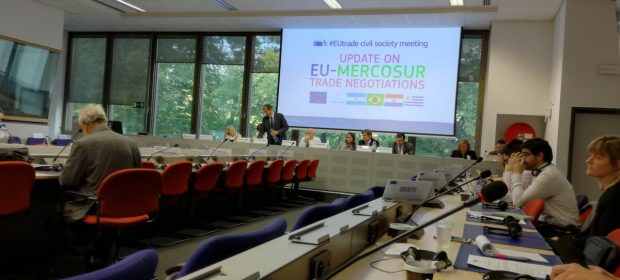What the European-Union Mercosur trade agreement means for copyright

Public Knowledge | 12 December 2017
What the European-Union Mercosur trade agreement means for copyright
By Luis Gil Abinader
After years of failed negotiations, the European Union now appears close to reaching a trade agreement with the South American political and economic bloc, Mercosur. This was confirmed by the European Union Trade Commissioner Cecilia Malmström during a press conference last month. The announcement came a day after the European Union Vice-President, Jyrki Katainen, met in Buenos Aires with the Argentinian President, Mauricio Macri, to work on unspecified “difficult issues” still pending.
The European Union Copyright Proposal
In addition to topics like sanitary standards in agriculture or car tariffs, these European Union-Mercosur trade talks will likely include provisions regulating the internet. Particularly, this agreement may expand the length and scope of copyright protection. Last year, the European Union announced its intellectual property proposal for this agreement. Although several negotiation rounds have taken place, this draft chapter remains our primary source of information for scrutinizing the copyright negotiations since both groups have barred civil society and the general public from participating in this process.
Many of the intellectual property provisions raised by the European Union in this agreement are bad for internet users. The European Union proposal seeks to erode the public domain by extending the copyright term of protection to life plus 70 years, which prominent scholars characterize as unwise and unjustified. It also seeks to ban the circumvention of technological protection measures, which would limit a user’s autonomy over legitimately purchased digital content and devices. Additionally, it aims to restrict public policies on mandatory disclosure of source code, therefore impeding measures that could strengthen cybersecurity. Finally, it fails to include strong language on copyright exceptions and limitations, a standard that even the Trans-Pacific Partnership (TPP) met.
In October the European Union reported that the copyright negotiations were “almost closed.” In the same report, the European Union admitted that “further work on exceptions” is still necessary and that “there remains a general divergence of positions regarding the level of ambition in this area.” It is unclear whether or which aspects of the reportedly “almost closed” copyright section are among the “difficult issues” that the European Union and Mercosur political leadership are trying to resolve.
Impact for Mercosur Countries
If adopted, many of the European Union copyright proposals will require legal reforms that would further restrict the public domain and user rights in Argentina, Brazil, Paraguay, and Uruguay.
For example, the term of copyright protection in Uruguay is life plus 50 years, the minimum required by the World Trade Organization (WTO) Agreement on Trade-Related Aspects of Intellectual Property Rights (TRIPS). Uruguay may have to extend the length of copyright terms of protection in order to comply with the new European Union-Mercosur obligations. Similarly, Argentina may have to introduce penalties against users that circumvent technological protection measures, a sanction that in its current form the national copyright law 11,723 lacks.
In other cases, these proposals will lock in existing norms, undermining sound policy debates around them. An example of this is the copyright term of protection in Argentina, Brazil, and Paraguay, which is unnecessarily above the minimum required by the TRIPS Agreement.
Beyond Mercosur
The European Union and Mercosur are hoping to announce an agreement during the WTO Ministerial Conference in Buenos Aires, happening now. This is hardly a coincidence. With the Trade in Service Agreement (TiSA) negotiations, the European Union is candidly pursuing a “modular approach” strategy for international harmonization: while the first phase is negotiating a plurilateral agreement, the ultimate goal is to make these norms multilateral. Prior U.S. administrations have also explicitly recognized that they too implement a similar strategy. The idea is that ambitious multilateral harmonization is difficult to accomplish, but it may be feasible if negotiated modularly through bilateral or regional agreements that can later be docked all together into the WTO system.
Although this modular approach might not have been an intended objective when the interregional talks were launched around 17 years ago, it probably is an additional benefit for the EU now. The four Mercosur members are among the few Latin American countries that have not yet signed bilateral or regional TRIPS-Plus commitments with either the U.S. or the EU. This means that they still have strong motives to oppose multilateral norms that would impose additional intellectual property obligations. However, if Mercosur countries agree to adopt higher intellectual property standards with the EU, they will lose a great deal of political leverage to continue opposing those same provisions at the WTO. Binding Mercosur to TRIPS-Plus standards may therefore facilitate future harmonization efforts at the WTO.





